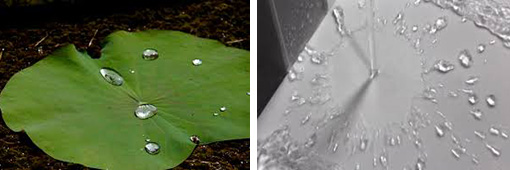Smart, clean surfaces are the dream of many housekeepers. The vision of giving up on windows cleaning, washing clothes, scrubbing and polishing dirty surfaces with chemical agents is very tempting. Technology comes out to meet it, but the most suitable applications have yet to be settled.
All these things are possible thanks to hydrophobicity. Hydrophobicity is the physical property of a molecule that is not attracted to water. The term hydrophobe comes from the Ancient Greek ὑδρόφοβος, which means “having a horror of water”, constructed from ὕδωρ, “water”, and φόβος, “fear”. Usually, hydrophobic molecules are nonpolar and they prefer neutral molecules and nonpolar solvents. In water, they cluster together and form micelles. To measure hydrophobicity, researchers use a device called goniometer, which show the contact angle between a drop of liquid and surface. The angle can be in the range from 0 to 180 degrees. When it is smaller than 90 degrees, the surface is hydrophilic and the liquid moistens it well, in other words, the surface is getting wet. Between 90 and 180 degrees, we deal with hydrophobic material, which means that liquid doesn’t moisten it well. Situations, where the contact angle is 180 degrees, are not present in nature.

The idea of superhydrophobic surfaces comes from Lotus effect phenomenon, which is related to rough hydrophobic surfaces. It was discovered by Dettre and Johnson in 1964. The self-cleaning materials are based on the superhydrophobic coating, which is a nanoscopic surface layer that repels water. Such a coating can be made from many different materials. Possible bases for coating are for example nano-composites, carbon nanotubes structures or precipitated calcium carbonate.

Super-hydrophobic coatings are used in ultra-dry surface applications. The coating creates a really thin layer of air on the surface. In nature, superhydrophobic coatings are found in mentioned Lotus leaf and in wings of some insects. There is also a possibility to spray the coating onto some objects and make them waterproof. The spray has cleaning capabilities, is anti-corrosive and anti-icing. Superhydrophobic coatings can be used in maritime industry to reduce corrosion and increase a speed of ships. There are also future plans of using it with surgical tools, medical equipment, textiles and much more. For more examples check the links below.
– by Milena G. –
sources:
https://www.azom.com/article.aspx?ArticleID=7881
http://www.sciencedirect.com/science/article/pii/S1369702103011313

